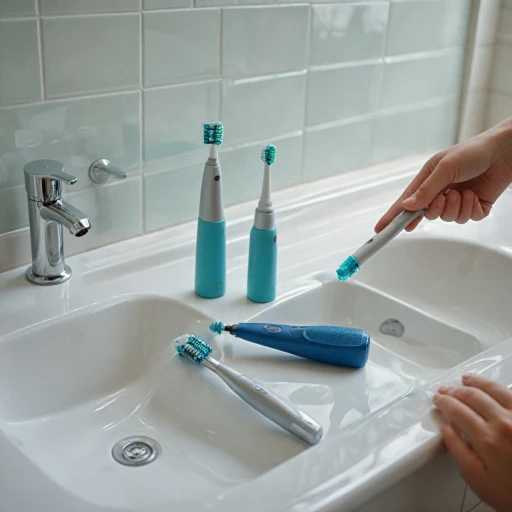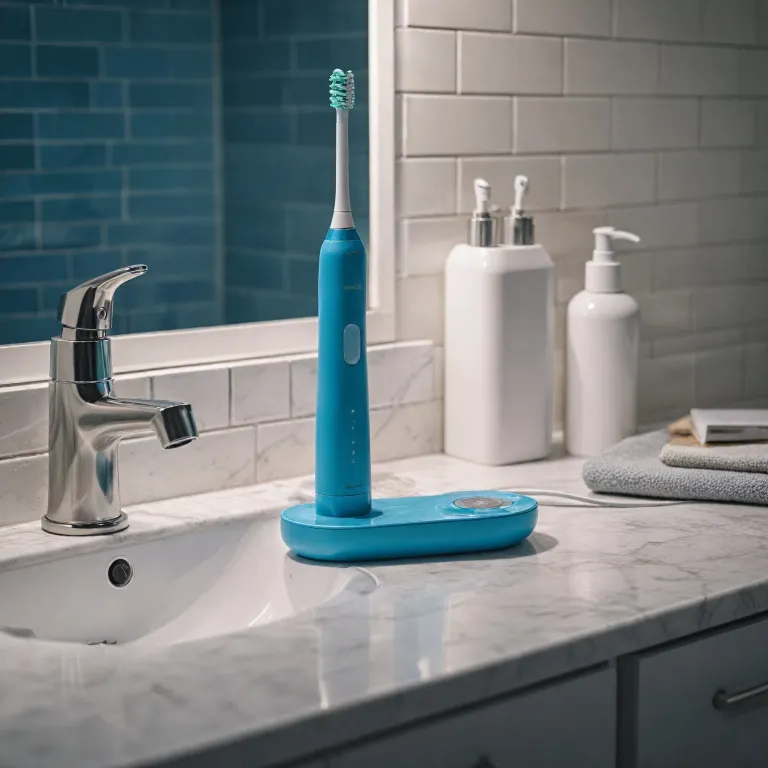Understanding Common Charging Problems
Identifying Why Your Toothbrush Won't Charge
When your Philips Sonicare or Sonicare DiamondClean toothbrush isn't charging, it's essential to explore potential causes to devise an effective solution. Charging issues can be surprisingly common but often easy to resolve.
First, ensure that your toothbrush is properly seated on its charger. A common problem arises if the device is not aligned correctly with the toothbrush charger. Make sure the bottom of your toothbrush is seated flatly on the charger, allowing the charging light to illuminate. If your toothbrush charge light doesn’t turn on, it might indicate a charging issue.
Next, examine the charger itself by connecting it to a different outlet. Malfunctioning power outlets sometimes cause charging problems. Plugging the charger into a known functioning outlet helps rule out this particular issue and can identify whether the outlet is the cause.
Also, inspect the charger for any visible damages or fault conditions. A damaged charger may need to be replaced and a replacement should be considered if the problem persists.
Remember, charging issues could also be due to the battery itself. For more information on navigating battery-related challenges and the average lifespan of toothbrush batteries, you can visit a comprehensive guide on
understanding the lifespan of toothbrush batteries. This will help determine if a battery replacement is needed for effective maintenance of your Sonicare toothbrush.
By taking these initial steps to troubleshoot, you can often identify the root cause of the charging issue and move towards a solution without needing to skip to professional maintenance or warranty options. Addressing common issues at home can save time and prevent unnecessary service charges.
Troubleshooting Your Toothbrush
Step-by-Step Troubleshooting Guide
If your Philips Sonicare toothbrush, like the Sonicare DiamondClean or FlexCare, doesn’t charge, it’s essential to go through a systematic approach to identify the issue. Here are some steps you can take to ensure your toothbrush starts charging efficiently:
- Check the Outlet and Charger: Ensure the outlet charge is functional. Plug another device into the same outlet to confirm it is working. If not, try a different outlet. Also, inspect the toothbrush charger for any visible damage or defects that might prevent the toothbrush from charging.
- Inspect the Toothbrush and Battery Light: Examine the charging light on your toothbrush. If it doesn’t illuminate, it could indicate a problem with either the battery or the charger. The battery light serves as a key indicator of your toothbrush's charging status.
- Verify the Brush Head Placement: Make sure that the brush head is securely attached to the handle. A loose or improperly attached head might disrupt charging. Remove and reattach the brush head to ensure it's in place.
- Test the Bottom of the Toothbrush: Inspect the bottom of the toothbrush handle for any dirt or moisture, which can impede the connection between the charger and the toothbrush. Wipe it clean and dry before attempting to charge again.
- Evaluate the Toothbrush Vibration: If the toothbrush doesn’t turn on or doesn’t vibrate as expected, this could be related to a charge issue. A weak battery may not provide enough power for effective brushing, necessitating a different troubleshooting approach.
- Timing and Patience: Allow the toothbrush to remain on the charger for a longer period, as sometimes it takes additional time for a completely drained battery to respond. Ensure it's correctly aligned on the charging base.
If after following these steps your toothbrush still doesn't charge, further actions might be necessary. You can delve deeper into understanding the lifespan of toothbrush batteries by reading this
detailed guide to better understand your Philips Sonicare device.
Battery Life and Maintenance Tips
Prolonging the Life of Your Toothbrush's Battery
Proper maintenance and usage can help prolong your toothbrush's battery life, reducing the frequency of replacements and ensuring a consistent level of performance. Here are some practical tips to enhance your Philips Sonicare device's lifespan:
- Regular and Full Charging: It is important to allow your toothbrush to fully charge before using it. When the charging light indicates it is fully charged, this practice ensures that the battery retains its full capacity over time. If the toothbrush doesn’t show a solid indicator on the charger, check your outlet to ensure the device is plugged properly.
- Avoid Overcharging: While it’s essential to keep your toothbrush charged, leaving it on the charger constantly can diminish battery life. Once the Philips Sonicare is fully charged, it is advisable to remove it from the outlet to maintain optimal battery health.
- Store in a Cool, Dry Place: High temperatures can negatively affect the battery. Therefore, store your toothbrush in a place where it can remain at a stable temperature, ideally away from direct sunlight or excessive humidity.
- Routine Cleaning: Regularly clean the brush head and the base to prevent any debris buildup, which might interfere with the toothbrush's ability to charge properly. Keeping the charging port at the bottom clean is crucial for efficient operation.
- Head Replacement: Using an appropriate brush head for your Philips Sonicare DiamondClean or FlexCare can affect how efficiently your toothbrush performs. Opting for head replacement at the recommended intervals can contribute to the device's overall health.
By following these tips and maintaining a mindful approach to your toothbrush’s usage, you can optimize its battery longevity, preventing unnecessary charging issues. In case your toothbrush doesn’t start to vibrate or the toothbrush charger doesn’t respond as expected, ensuring all components of the toothbrush charging process are functioning correctly may help resolve these issues before they escalate. For additional care tips, you can explore more on natural toothbrush solutions
here. Remember, taking care of the detailed aspects of your device can prevent the need for constant replacements and maintain its performance and longevity.
When to Seek Professional Help
Recognizing When to Get Professional Assistance
If your Philips Sonicare toothbrush still isn't charging despite your troubleshooting efforts, it might be time to consider professional help. Understanding the right moment to consult with a professional can save you time and ensure that your device returns to optimal performance.
- Consistent Charging Problems: When your toothbrush doesn’t seem to charge even with different outlets or chargers, it points to deeper issues that might require professional repair or inspection.
- Battery Light Indicator: If the battery light behaves erratically—blinking or flickering without reason—or doesn’t activate at all, this could signal an internal fault with the battery or the charging unit.
- Physical Damage: Visible damage to the toothbrush, charger, or charging base, especially around the bottom where the device is plugged, could mean it's time to reach out to a service center. Physical inspections by professionals can sometimes resolve issues not visible to an untrained eye.
- Persistent Non-Functionality: If your device refuses to turn on despite attempts to charge it, there could be a deeper malfunction at play. An expert will be equipped to diagnose this more accurately.
Contacting a professional service for your Philips Sonicare, whether it's for the Sonicare DiamondClean or FlexCare models, helps ensure that any repairs or replacements are done correctly. Philips offers support and service options that can guide you through the warranty process if applicable, or suggest suitable replacement alternatives when necessary.
While some issues can be resolved at home, professional intervention provides a reliable solution to maintain or restore your toothbrush's performance, ensuring it continues to meet your dental care needs efficiently.
Exploring Warranty and Replacement Options
Evaluating Your Warranty Coverage
If your Philips Sonicare toothbrush isn’t charging despite troubleshooting, you might consider exploring warranty and replacement options. Checking the warranty status could be the key to resolving a non-functioning device without additional costs. Philips typically offers a two-year warranty on their models, like the Sonicare DiamondClean and FlexCare, which covers defects in materials and workmanship.
Navigating the Warranty Process
It’s crucial to know what your warranty covers and how to initiate a claim. Here are some steps to make the process smoother:
- Find your proof of purchase; this is often required to validate your warranty claim.
- Visit the official Philips support website for specific instructions related to your model.
- Fill out any necessary forms or contact customer support to discuss your charger or battery issues.
- Package your toothbrush, ensuring it includes all parts—charger, brush head, etc.—when sending it in for service.
Replacement Considerations
If your toothbrush falls outside the warranty period, or the issue isn’t covered, replacement might be an option. Philips usually offers replacement parts such as the toothbrush charger and brush head at a reasonable cost. Keep an eye on the battery light behavior; if the device doesn’t light up when plugged into the outlet, the charger or toothbrush bottom might be faulty.
Weighing Upgrades and Alternatives
Sometimes, investing in a new model could be more practical, especially if your current device shows persistent issues. Upgrading to a model with additional features may enhance your oral hygiene routine. For more insights into different electric toothbrush options, researching their distinct functionalities can be beneficial. If your budget allows, exploring upgrades might offer better performance and longer battery life, helping you avoid future warranty or replacement concerns. Remember that understanding your specific needs is vital in making an informed decision.
Alternative Solutions and Upgrades
Considering Alternatives and Enhancements
When your Philips Sonicare toothbrush doesn’t seem to respond, despite trying every method to charge it, you might contemplate other routes to maintain that optimal oral hygiene. While a non-functional toothbrush might spur immediate concerns, there are positive alternatives and improvements you can explore.
- New Charging Accessories: If your current charger fails to perform, consider purchasing a new toothbrush charger compatible with your model, whether it's a Sonicare DiamondClean or FlexCare. This could swiftly resolve any connection issues if the charger itself was the source of the problem.
- Enhanced Brush Models: In cases where the brush or battery doesn’t cooperate, upgrading to the latest Philips models with improved battery life and brush head replacements can be worth the investment. The newer models frequently feature advanced toothbrush vibration settings and more sophisticated battery lights, ensuring a better daily dental care routine.
- Explore Outlet Variants: Check if using alternative outlets can help. Sometimes, the outlet charge performance might be inconsistent, especially if the outlet itself is the problem.
- Backup Devices: Keeping an extra manual toothbrush in your bathroom cabinet or travel kit will assure you’re always equipped, even when your electric device doesn’t turn on or charge effectively.
- Stay Informed: Enhance your knowledge on preventive measures, like periodic charger cleaning or main content adjustments on your device, helps manage its maintenance and longevity. This can be pivotal in preventing serious issues in the future.
In ensuring your toothbrush charging issues get addressed promptly, these considerations and potential upgrades can keep you on the path to healthy teeth and gums, maintaining the standards you expect with your Philips Sonicare experience.

